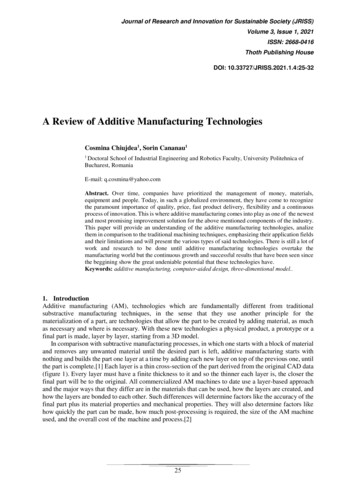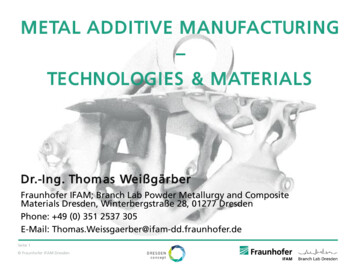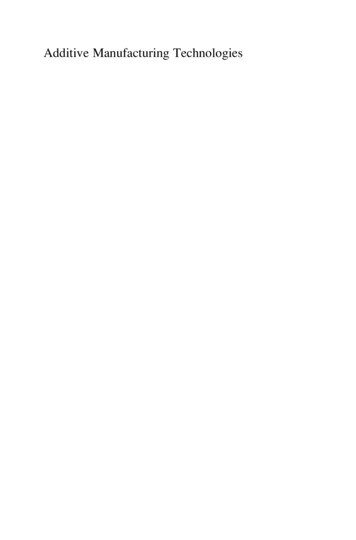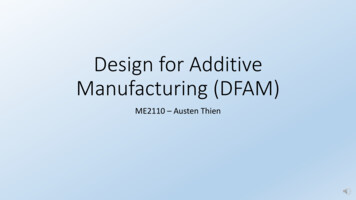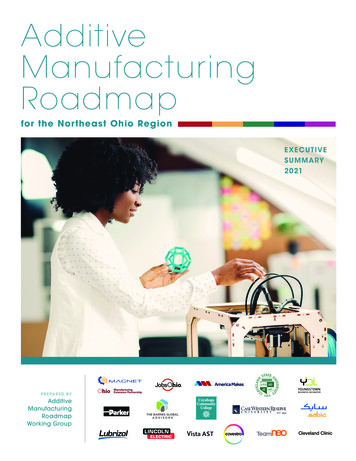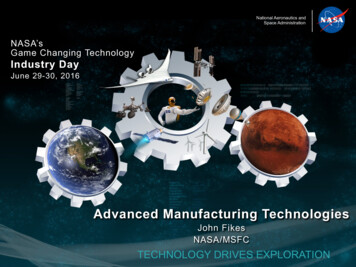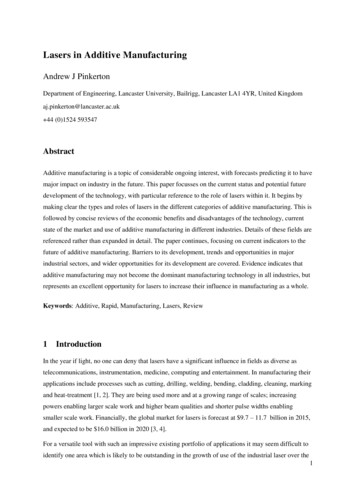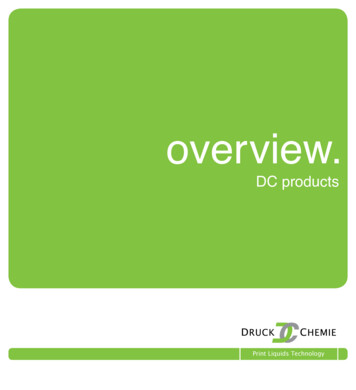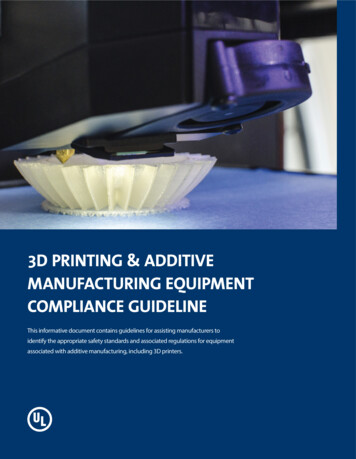
Transcription
3D PRINTING & ADDITIVEMANUFACTURING EQUIPMENTCOMPLIANCE GUIDELINEThis informative document contains guidelines for assisting manufacturers toidentify the appropriate safety standards and associated regulations for equipmentassociated with additive manufacturing, including 3D printers.
3D PRINTING & ADDITIVEMANUFACTURING EQUIPMENTCOMPLIANCE GUIDELINEEquipment Associated with Additive Manufacturing, including 3D Printing
3D PRINTING & ADDITIVE MANUFACTURINGEQUIPMENT COMPLIANCE GUIDELINECONTENTSIntroduction. 41.Scope. 52.Reference Publications. 53.Definitions. 64.Guidelines. 64.1General. 64.2Standards. 74.3Regulations. 7Annex A Questions Assisting Identification of Applicable Standards & Regulations for 3D Printers. 8Annex B Standards & Technical Committees Associated with 3D Printers. 9Annex C Machinery Directive. 10Annex D 3D Printers Intended for Use by Children in Schools. 13Annex E Regulations Associated with Airborne Emissions and Explosive Atmospheres.14Annex F Regulations Associated with Potentially Combustible and Explosive Atmospheres . 153D Printing & Additive Manufacturing Equipment Compliance Guidelinepage 3
INTRODUCTIONThis informative document contains guidance for identifying the appropriate safetystandards and regulations for equipment associated with additive manufacturing,including 3D printers.The driver for this guide is to associate additive manufacturing technologies and equipmentwith relevant, existing safety standards for the various current uses, including use ascommercial, industrial, consumer, food processing and medical equipment. It also beginsthe education process on regulatory considerations that manufacturers of 3D printers mayneed to have an awareness of.3D printing (more broadly referred to as additive manufacturing) is the process of usingspecialized equipment to build a physical object from a three-dimensional digital model,typically by layering many successive thin layers of a material, such as polymers or othermaterials.Additive manufacturing technology is most commonly utilized for modeling, prototyping,tooling and short-run production applications. This type of equipment is typically used in acontrolled environment and the users of the equipment are typically instructed how to usethe equipment in a production line/manufacturing setting.More recently, the technology has been commonly utilized by do-it-yourselfers, hobbyistsand tinkerers. Additionally, some manufacturers are introducing the equipment to be usedby consumers in the home, and even by students of varying ages in schools.Often, manufacturers have requested that this type of equipment be investigated to aninternational standard since the products are being marketed globally.page 43D Printing & Additive Manufacturing Equipment Compliance Guideline
1 - SCOPEThis informative Guide provides background and guidance on the use of existing safety standards that are applicable to equipmentassociated with various applications of additive manufacturing, including 3D printers.This Guide does not introduce new requirements, but references appropriate existing standards, which in most cases should adequatelycover the safety of this type of equipment. Appropriate supplemental considerations are provided, as necessary.The Guide also introduces known regulatory considerations that manufacturers of 3D printers need to be aware of and that can beimportant installation and use considerations as 3D printers are used in a wider variety of installation environments, and the associatedtechnologies that the 3D printers utilize expands.This Guide does not provide guidance on the standards that apply to the parts, components or end products that may be produced usingadditive manufacturing processes.2 - REFERENCE PUBLICATIONSIEC 60204-1, Safety of Machinery – Electrical equipment of machines – Part 1: General requirementsIEC 60335-2-14, Household and similar electrical appliances – Safety – Part 2-14: Particular requirements for kitchen machinesIEC 60335-2-64, Household and similar electrical appliances – Safety – Part 2-64: Particular requirements for commercial electric kitchenmachinesIEC 60335-2-75, Household and similar electrical appliances – Safety – Part 2-75: Particular requirements for commercial dispensingappliances and vending machinesIEC 60601-1, Medical Electrical Equipment – Part 1: General requirements for basic safety and essential performanceIEC 60950-1, Information Technology Equipment – Safety - Part 1: General requirementsIEC 62368-1, Audio/video and communication technology equipment - Part 1: Safety requirementsISO 12100, Safety of Machinery – General principles for design – Risk assessment and risk reductionISO/CD 17296-1, Additive manufacturing -- General principles -- Part 1: TerminologyASTM F2792 – 12a, Standard Terminology for Additive Manufacturing Technologies3D Printing & Additive Manufacturing Equipment Compliance Guidelinepage 5
3 - DEFINITIONS3.1ADDITIVE MANUFACTURINGa process of joining materials to make objects from 3D model data, usually layer upon layer, as opposed to subtractive manufacturingmethodologies.3.23D PRINTERmachine used for 3D printing.3.33D PRINTINGfabrication of objects through the deposition of a material using a print head, nozzle, or another printer technology.4 - GUIDELINE4.1.GENERALIdentification of the applicable standard(s) and regulation(s) for 3D printers associated with additive manufacturing typically depends onseveral factors, including,a)intended operating environment, for example home, office, factory, health care facility, bakery, school, etc.;b)intended type of user/operator of the equipment, for example ordinary persons (user or operator), skilled persons (service personnel), orinstructed persons (persons with limited training);c)specific technologies and energy sources integral to the equipment, for example laser, resistive heating, UV, etc.;d)specific raw materials involved in the printing, and any associated hazards that may be associated with use of these materials duringuse, or because of production of by-products, including material waste, dust, etc.; ande)local or regional regulatory requirements that specify particular requirements and/or standards for specific applications.Annex A provides some questions that may assist determining the appropriate product standards and regulations that likely will be associatedwith equipment for additive manufacturing, including 3D printers.4.2STANDARDS4.2.1SELECTION OF STANDARDGenerally, existing standards that cover similar types of equipment used in similar operating environments may be used for equipmentassociated with additive manufacturing. These standards are considered suitable since, although the application of the technology associatedwith additive manufacturing is relatively new, the basic hardware and technology used in the equipment are similar to other forms of hardwareand technology covered by existing equipment standards.page 63D Printing & Additive Manufacturing Equipment Compliance Guideline
See Annex B for information on applicable standards.NOTE Generally, the identified standards include requirements associated with,a.identification and classification of energy sources capable of personal injury or fire (for example, hazardous voltages);b.specification of required safeguards (for example, insulation and enclosures);c.determination of compliance of such required safeguards (for example, acceptance through prescriptive spacing requirements orperformance testing ); andd.other common aspects appropriate for such equipment, such as components, markings and instructions, and related considerations.See Annex C for information associated with the European Union (EU) Machinery Directive and how consideration of the Machinery Directivemay need to be factored into a manufacturer’s overall business risk management.4.2.2CONSTRUCTIONS NOT SPECIFICALLY COVEREDWhen the equipment involves technologies, materials or methods of construction not specifically covered by the chosen standard, theequipment should provide safeguards not less than that generally afforded by the applicable standard and the principles of hazard-based safetyengineering.NOTE IEC 62368-1 is a standard that incorporates hazard-based principles and may serve as an appropriate reference document forconstructions not specifically covered in other standards. See Clause 0 of the standard for an overview of the principles of the standard and anintroduction to hazard-based safety engineering.4.2.3REGULATIONSGenerally, regulations impacting equipment associated with additive manufacturing will depend on such things as installation environment (forexample, workplace or school), raw materials that are utilized, handled and stored (such as powdered metal), and any by-products, such as dust,that may be associated with the manufacturing processes. Other considerations may be valid too depending on the particular equipment andtechnologies involved.See Annex D for a discussion of potential regulations for 3D printers intended for use in schools.See Annex E for a discussion of potential regulations associated with airborne emissions and explosive atmosphere3D Printing & Additive Manufacturing Equipment Compliance Guidelinepage 7
Annex AQuestions Assisting Identification of Applicable Standards & Regulations for 3D printers1.What installation and/or operating environments does the manufacturer intend the 3D printer to be used in?a.2.Commercial (for example, office or ealth Care Facility?f.School (for example, primary, middle, junior or high school)?g.Hazardous Location (for example, in or near the presence of flammable gases)?h.Other?Who is intended to interface with the 3D printer?a.Ordinary person (user)?b. Instructed person (ordinary person given limited training)?c.Skilled person (service personnel)?d. Child (student), including intended or excluded age groups?3.Does the manufacturer want a product standard that covers a specific country or countries, or is the 3D printer aglobal product requiring acceptance in multiple countries/regions?4.Are there any local or regional regulations that explicitly cover the 3D printer by reference or interpretation?5.Does the manufacturer’s customer purchasing the 3D printer, including any retailers, specify minimumrequirements, standards and/or regulations that need to be met as a condition of sale?6.Does the 3D printer have any features that may cause it to be viewed primarily as a machine, such as equipmentwith considerable accessible mechanical (moving parts) or thermal energy sources (hot surfaces) as the primarypotential hazards (versus other more fully or partially enclosed units with enclosures or guards provided as operatorsafeguards)?7.Does the 3D printer use any raw materials that may have certain characteristics (e.g., highly combustible,or powdered form) that may result in installation or workplace regulations becoming an increasingly importantconsideration due to by-products from the printer, such as combustible dust or other air-borne emissions?page 83D Printing & Additive Manufacturing Equipment Compliance Guideline
Annex BStandards & Technical Committees (TC) Associated with 3D PrintersApplicationIEC StandardIEC TCEU Directives*US (UL) StandardsCommentsHome / OfficeIEC 60950-1, Safetyof ITEIEC TC108Low Voltage (LV),2009/95/EC,2014/35/EUUL 60950-1, Safetyof ITEFor US only applications,there may be otheroptions available, suchas UL 775, Graphic ArtsEquipment/ Business /CommercialIEC 62368-1, Safety ofAV & ICT EquipmentElectromagneticCompatibility(EMC), 2004/108/EC, 2014/30/EUUL 62368-1, Safety ofAV & ICT EquipmentFor US only applications,see US OSHAOccupational Safety andHEalth Standards, 29 CFR1910Restriction of theuse of certainhazardoussubstances (RoHS),2011/65/EUIndustrial(examples:manufacturing /factory floor)ISO 12100, Safety ofMachineryIEC 60204-1, Safety ofMachineryFood Preparation - IEC 60335-2-14, SafetyHouseholdof Commercail ElectricKitchen MachinesISO TC199IEC TC44IEC TC61Machinery (MD),2006/42/ECElectromagneticCompatibility(EMC), 2004/108/EC, 2014/30/EULow Voltage lity(EMC), 2004/108/EC, 2014/30/EUFood Preparation - IEC 60335-2-64,CommercialKitchen MachinesIEC TC61IEC 60335-2-75,Safety of CommercialDispensing Appliancesand Vending MachinesMedicalIEC 60601 -1, MedicalElectrical EquipmentLow Voltage (LV),2009/95/EC,2014/35/EUMachinery (MD),2006/42/ECUL Su 2011, FactoryAutomationEquipmentFor US only applications,there may be otheroptions available, suchas UL 775, Graphic ArtsEquipmentUL 982,Motor-OperatedHousehold FoodPreparing MachinesExample: 3D FoodPrinters for householduseUL 763,Motor-OperatedCommercial FoodPReparing MachinesExample: 3D FoodPrinters used in bakeriesand other facilitiesassociated with the foodindustryElectromagneticCompatibility(EMC), 2004/108/EC, 2014/30/EUIEC TC62Medical Devices(MDD), 93/42 EEC;ElectromagneticCompatibility(EMC), 2004/108/EC, 2014/30/EUANSI/AAMI 60601-1,Medical ElectricalEquipment* See Annex C for information on the EU Machinery Directive (2006/42/EC).3D Printing & Additive Manufacturing Equipment Compliance Guidelinepage 9
Annex CMachinery DirectiveIntroductionIn Europe, the Machinery Directive (2006/42/EC) exempts six categories of electrical machinery from the Directive and directs them to theLow Voltage Directive (2014/35/EU), thus they are not subject to the risk assessment provision and related aspects of the Machinery Directive.Included in these exemptions are “ordinary office machinery,” “information technology equipment,” and “household appliances intended fordomestic use.”However, some authorities/regulators are taking a view that 3D printers are general ‘machines’ and not ‘ordinary office machinery’, and as aresult they are not covered by the existing product safety standards associated with the EU Low Voltage Directive (LVD). Therefore, some ofthese products are being required by EU authorities to meet the provisions of the Machinery Directive.As a result, for 3D printers used in offices, homes and similar locations, there remains some question whether this equipment is coveredunder the scope of EN 60950-1 or EN 62368-1, standards that are used to assess safety of traditional 2D printers under the LVD. 3D printers,while having some similar characterizations and features of their 2D printer predecessors, also have some hardware-based features thatsome authorities/regulators tend to consider more similar to machines. While certainly there is not a universally held opinion on this subject,manufacturers of 3D printers need to be aware that selection of a product safety standard, and compliance with such a standard, may be oflimited value if an authority/regulator does not accept the standard as meeting local or regional regulations.To attempt to help the situation, IEC TC108 is taking action to include such 3D printers in IEC 62368-1’s Annex A as an example of equipmentcovered under the scope of IEC 62368-1. However, the next version of IEC 62368-1 may not be published until 2017/2018.It is expected some of these issues related to appropriate standards will be more formally clarified in both IEC and EU standards and regulationsin the new few years.Due to the uncertainty in the European regulatory environment, manufacturers of 3D printers should consider the need to make a businessrisk management-based decision whether they are comfortable relying on a product safety standard covered by the LVD, or whether they wantmore assurance that the product likely will be viewed by EU regulators as a machine.Since some 3D printer manufacturers may not be familiar with the basics of the Machinery Directive, this Annex concludes with an overview ofthe Directive and its provisions.Machinery Directive - OverviewDirective 2006/42/EC (formerly 98/37/EC) applies to machinery, lifting accessories, and associated safety components. The intent of theDirective is to introduce identical requirements for machinery safety for all countries within the European Economic Area (EEA).In the Directive, a machine is defined as “an assembly of linked parts or components, at least one of which moves ” This definitionencompasses a large range of machines, from simple hand-held power tools through complete automated industrial production lines. There areexclusions, such as for machines which are already covered by other specific directives, including equipment which falls under the scope of theLow Voltage Directive.page 103D Printing & Additive Manufacturing Equipment Compliance Guideline
For example, certain specific types of equipment fit the definition of machinery but are also within the scope of the Low Voltage Directive– as a result they are excluded from the Machinery Directive on the basis that the risks they present are mainly electrical in nature. Theseinclude “ordinary office machinery” and “household appliances for domestic use”.The Machinery Directive is mutually exclusive with the Low Voltage Directive, so that either one or the other will apply but not both. AnnexI of the Machinery Directive contains requirements for electrical safety, which are based on those of the LVD, so the safety requirements ofthe two directives are comparable; however, the Declaration of Conformity will cite the Machinery Directive and not the LVD.Machinery DirectiveThe vast majority of machinery may be self-certified by the manufacturer who must meet the administrative and essential health andsafety requirements of the Directive.The essential health and safety requirements require manufacturers of machinery to identify the hazards that their equipment contain andassess the risks these hazards present to users. Any risks identified must be reasonably reduced to as low a level as practicable.More specifically, Annex I of the Directive gives a comprehensive list of the potential hazards which may arise from the design and operation ofmachinery, and gives general guidance on what hazards must be avoided. The key provision of Annex I is the need for a risk assessmenton the machinery, which helps determines the specific application of the essential health and safety requirements. Detailed requirements are laid out in a series of safety standards. A standard that has been accepted by the European Commissionvia the process of harmonization is considered a European Norm (designated with 'EN' prefix). Documented conformance with therequirements of the standard gives a ‘presumption of conformity' with the requirements of the Directive. Because so many standards are required to cover the full range of machines within the scope of the Directive, the European standardsbodies devised a hierarchy to be applied. Type A standards: These are the most basic standards that set out basic requirements for the safety of machines, including EN ISO12100:2010, Safety of machinery - General principles for design - Risk assessment and risk reduction. Type B standards: These standards address more specific issues, such as design of emergency stops (EN ISO 13850); prevention ofunexpected start-up (EN 1037); temperature of touchable surfaces (EN ISO 13732-1), etc. Type C standards: These standards deal with specific types of machine: for example, EN 1012 deals with safety of compressorsand vacuum pumps; EN 792 deals with pneumatic hand tools and EN 201 deals with injection moulding machines for rubber orplastic. There currently is not a specific Type C standard for 3D printers.The administrative provisions of the Directive require manufacturers to provide documentary evidence that the machinery complieswith the Directive, produce a Technical File, sign a Declaration of Conformity, and label the product with certain markings. The vastmajority of machinery may be self-certified by the manufacturer, or an authorized representative within the EU. Therefore, as long as theadministrative and safety requirements of the Directive are properly satisfied, the manufacturer can perform all of the assessment anddocumentation procedures themself and does not need formal external test or approval. continued.3D Printing & Additive Manufacturing Equipment Compliance Guidelinepage 11
Annex C continuedMachinery DirectiveMore specifically, The general form and content of the Technical File is specified in the Directive and manufacturers are obligated to make this informationavailable for inspection by the authorities for up to 10 years after the date on which the machine was sold. However, except for machineslisted in Annex IV, there is no obligation to produce a copy of the file unless demanded to do so by the enforcement authority. Also, only theenforcement authority has a right to see it; the manufacturer does not have to provide a copy to a customer unless they choose to. Machinery meeting the Directive is required to have the CE mark clearly affixed to indicate compliance. It also is to include the year ofmanufacture, serial number, and other ratings as required by the relevant standards. An item of equipment may only display the CEmark when the equipment satisfies all relevant directives; for instance machines with electronic functions also need to comply with therequirements of the EMC Directive. The manufacturer is required to prepare and sign an 'EC Declaration of Conformity', which is a statement that provides the identity of themanufacturer and the machinery for which the manufacturer is claiming compliance. It is signed to confirm that the correct procedureshave been followed. If the manufacturer is based outside the European Community, this Declaration must also contain the address of arepresentative within the EU from whom the authorities can obtain the technical documentation.Annex IV of the Directive contains a list of numerous types (about 25) of machines that are subjected to special procedures. These must either bemade fully in accordance with the provision of the standard, or must be subjected to type examination by a Notified Body. 3D printers are notlisted in Annex IV.Apart from the EMC and Low Voltage directives mentioned above, other directives that also may affect some equipment falling within the scopeof the Machinery Directive include, Directive 2000/14/EC on the noise emission of equipment intended for use outdoors; and Directive 2002/44/EC on human body exposure to vibration.For machinery intended for use in a flammable atmosphere, the ATEX Directive applies (see Annex E of this Guide), and, additionally, theRestriction on Hazardous Substances (RoHS) and Waste Electrical & Electronic Equipment (WEEE) Directives also may apply to machines thatcontain electrical equipment, including 3D printers.For machinery intended for use in a flammable atmosphere, the ATEX Directive applies (see Annex E of this Guide), and, additionally, theRestriction on Hazardous Substances (RoHS) and Waste Electrical & Electronic Equipment (WEEE) Directives also may apply to machines thatcontain electrical equipment, including 3D printers.page 123D Printing & Additive Manufacturing Equipment Compliance Guideline
Annex D3D Printers Intended for Use by Children in SchoolsGenerally, products intended primarily for use by children often are subjected to more restrictive regulations than products intendedprimarily for use by adults.For example, in the U.S., children's products are subject to a set of federal safety rules, called children's product safety rules. The U.S. lawdefines a "children's product" as a consumer product designed or intended primarily for people 12 years of age or younger.Therefore, for 3D printers intended for use by people above 12 years of age, the US federal regulations generally are not more restrictivethan for adults. It is expected most 3D printers intended to be used in schools will be for use by children above 12 years of age under adultsupervision, although this expectation could change further as 3D printers become prevalent in classroom environments.However, if a manufacturer targets the use of a machine by children 12 years of age and younger, there are additional regulatoryconsiderations. Parts of the U.S. Code of Federal Regulations may be applicable, mainly, Title 16, Chapter II, Subchapter C, Part 1505,Requirements for Electrically Operated Toys or Other Electrically Operated Arcticles Intended for Use By Children.For such applications, the Consumer Product Safety Commission (CPSC) has given some guidance on what types of products are considered‘children’s products’ and what types are not. Although 3D printers currently are not specifically mentioned in any of the guidanceinformation, there is some guidance given on science kits and related products when primarily intended for children 12 years of age oryounger. That guidance is reproduced here for reference purposes.What about science kits or other "kits" designed and primarily intended for children 12 years of age or younger-are they considered"children's products"?Using the four-factor analysis set forth above [(a) intended use by manufacturer, (b) packaging, advertising, and general marketing, (c)whether product is commonly recognized by consumers as a children’s product intended for 12 years of age or younger, (d) CPSC AgeDetermination Guidelines] , if it is determined that the "kits" are designed and primarily intended for children 12 years of age or younger,then all elements included in the kit are considered "children's products," and they must comply with the standards. For example, a paperclip, ordinarily a general use item, included in a "magnet kit," would be considered a children's product when it is part of the kit. Whenmanufacturers use component parts or materials not otherwise intended for children and they repurpose those parts or materials ascomponents in their children's products, those manufacturers become responsible for ensuring compliance with children's product safetystandards.*For Europe, although some products intended for use by children are subjected to Directive 2009/48/EC on the safety of toys (Toy Directive),3D printers intended for schools are not currently mentioned anywhere in the Directive, nor the associated Guidance documents, such asGuidance document No. 16 on electronic equipment aimed at children’s use, so it’s unlikely this Directive and the associated standardsreferenced in it would be applied for 3D printers used in schools.*Courtesy of U.S. CPSC’s FAQs: Children’s Products - ucts/ .3D Printing & Additive Manufacturing Equipment Compliance Guidelinepage 13
Annex ERegulations Associated with Airborne EmissionsIn general, when compliance of equipment is considered in the context of product safety standards and regulations, typically there are severalkey aspects that need to be considered. These include (a) safety of the product itself and safe use/handling of the product by operators andservice personnel, typically as defined by consensus safety standards, and (b) safe operation of the product in the environment it is intended tobe used in accordance with any installation regulations associated with safe use and protection of consumers and workers in the workplace.As discussed earlier in these Guidelines, identification of the appropriate product safety standards for 3D printers is somewhat fluid and is likelyto continue to be so until the associated standards bodies study closer whether additional requirements in product standards are needed for 3Dprinters.Similarly, from a regulations perspective, there also remains some uncertainty.For example, it is difficult to be definitive on the applicable regulations associated with indoor air-quality emissions resulting from the intendedfunction of the 3D printer equipment because, (a) such requirements are not currently associated with the minimum safety standards for otherforms of equipment used in similar environments, including 2D printers; (b) the air quality associated with the equipment is directly dependenton the raw materials associated with the production (printing) process and the manufacturer may not always have on-going control of theuse of such raw materials; and (c) associated voluntary requirements for airborne emissions are like to further evolve in the context of additivemanufacturing equipment.In the U.
ASTM F2792 - 12a, Standard Terminology for Additive Manufacturing Technologies. page 6 3D Printing & Additive Manufacturing Equipment Compliance Guideline 3 - DEFINITIONS 3.1 ADDITIVE MANUFACTURING a process of joining materials to make objects from 3D model data, usually layer upon layer, as opposed to subtractive manufacturing
